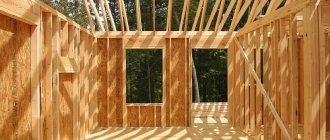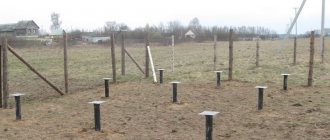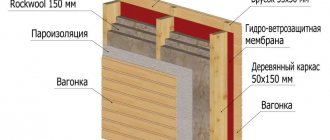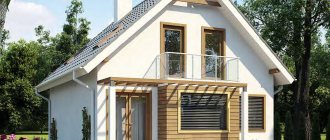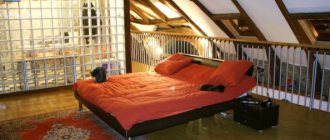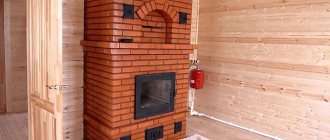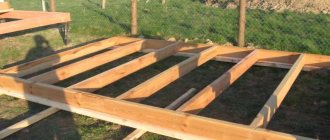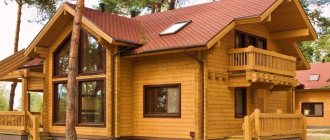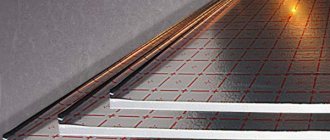By basalt chips (backfill) we mean crushed scraps left over from basalt wool. This material is successfully used in filling interwall voids, arranging floors, attics, and roofing. The material is characterized by non-flammability, vapor permeability (not prone to moisture accumulation), noise insulation properties, and natural origin. In addition, the material does not rot.
Method for preparing moistened fillings
Layers of binder and organic fillers are poured into the gap.
Then mix everything well and add water. After 3-5 weeks, the backfill in the structures dries with slight compaction and settlement. Drying time varies depending on air temperature. Such backfills should not be used in frame wooden buildings together with vapor barrier materials (roofing felt, roofing felt, glassine, etc.). They take a long time to dry out and sometimes cause fungus to form. As you know, fungus is very harmful to wood. Plates made from organic materials are considered better insulation. Their size should be 50×50 or 70×70 cm, and thickness from 5 to 10 cm. The ratio of components for their preparation:
- 1.5 parts quicklime + 0.3 parts cement + 2-2.5 parts water;
- or for 1 part by weight of organic filler take 4 parts clay dough + 0.3 parts cement + 2-2.5 parts water;
- or 1-2 parts of tripoliform clay + at least 0.7 parts of quicklime (fluff can be used) + 2-3 parts of water;
- or 1.5-2 parts of gypsum + 2-2.5 parts of water.
If lime paste is used, then the amount is doubled and the amount of water is reduced.
First, dry materials are mixed, then moistened with water and mixed again until smooth. After this, the mixture is placed in molds, leveled, the molds are removed and dried under a canopy or indoors. Drying time will depend on temperature conditions and the binder used. Plates made of gypsum, lime, and tripoli dry for 2-3 weeks, clay products - on average about 4-5 weeks.
Frame, frame-panel, panel walls and those walls that are mounted from elements manufactured at the factory are considered more economical.
A wooden frame is a kind of structure consisting of lower frames that are laid on the foundation. The elements of such a frame are connected with nails and bolts. If the frame is paved, then staples are used. The frame posts are sheathed with boards. The distance between the outer and inner cladding is filled with a special insulating backfill, straw or reed mats, or other slab insulation materials. For frame buildings manufactured at a factory, the outside of the plank cladding is often covered with cladding made of asbestos-cement sheets.
The popularity of insulation in the form of mats or slabs is understandable - they are easy to transport, convenient to work with, while saving time. But often builders use another type of thermal insulation - backfill. It differs from foam or mineral wool boards in its structure. It is possible that for some applications, backfill insulation will be more preferable.
The insulation is a low-density porous material, the granules of which are produced by firing foamed raw materials at high temperatures. The ease of manufacture is reflected in the low cost of thermal insulation, and the structure also allows saving on labor costs.
The disadvantages of fill-in insulation are:
- their shrinkage by 10-15% of the initial volume;
- loss of thermal insulation properties when wet.
Loose-fill insulation is usually used for horizontal surfaces. The work seems simple, but requires careful preparation. For example, when insulating floors in buildings without basements, the soil is first compacted and covered with screed. Next, waterproofing material is laid on the latter, and insulation is poured onto it. It looks like the situation is the same with roof insulation, but no screed is required. Instead, a layer of vapor barrier is laid on top of the backfill material.
When covering walls, a frame consisting of durable sheet elements is constructed in advance. After this, insulation is poured inside the resulting structure.
Settlement of dry backfills
The main disadvantage of dry fill is that it settles and creates voids. Therefore, if they are used, the walls are erected 20-30 cm above the level of the ceiling beams, completely filled with backfill. As the backfill settles, it will fill the empty space. Under the windows, it is better to replace the backfill with fiber or tile materials. If there are none, install retractable window sills to add backfill through them.
To make the insulating backfill less friable, materials should be added to it that will turn it into a solid filler. For example, we take 85% sawdust and mix it with 10% fluff lime and 5% gypsum. In this case, the sawdust will harden and turn into the so-called thermolite. For such a mixture, wet organic materials or sawdust that have not undergone special drying are used. The sawdust is mixed with fluff, then this mixture is added to the plaster and immediately laid out in place, leveling and compacting well. The moisture present in the filler will slightly moisten the plaster and it will set. The filler will turn into a loose mass, thicken, and thanks to this it will not settle.
Basalt wool for furnaces
Let us say right away that basalt wool is not used directly for furnaces as a heat insulator. It can be used to fill cavities between the wall and the fuel channel when the latter passes through the cutting wall, but no more. The same applies to the pipe passage through the ceiling.
However, basalt wool is often used for chimneys.
For chimney
We hope that the owner selected the power of the stove to suit the volume of the room, and the diameter, length, and material of the chimney to suit the characteristics of his stove and the structure as a whole. These are all important points that influence each other. After all, the chimney creates draft, and this happens when its entire length is quickly heated, there is no condensation in it, and the inside is not overgrown with soot.
Watch a video that explains all these dependencies:
For the chimney: which one to choose?
Let's start with the fact that chimneys, after all, are different. And the temperatures in them also differ. If you are sure that the temperature inside yours does not exceed 300 degrees , then there is no need for high-temperature insulators. Although it's up to you to decide. Dense basalt wool has normal operating temperatures of 450-700 degrees. That is, any type of it can be used on chimneys, because the temperature of even the furnace gases burning inside will not raise the temperature of the pipe above 600 degrees.
However, keep in mind that sandwich pipes are not designed for temperatures above 300 degrees - this is because the metal apparently burns out.
So, which basalt wool to choose for a chimney? At your disposal are flexible mats and dense shells , as well as foil varieties. There is also basalt cardboard - a good thing, but it is no longer cotton wool. Cardboard holds up to 900 degrees!
Choose shells if you are sure that the temperature in your chimney does not rise above 300 degrees.
Flexible mats are useful if the temperature in the chimney is not higher than 700 degrees.
As for the material from which the chimney is made, this is an important point. Because for a ceramic pipe there is no problem that it can be exposed to very high temperatures for a long time, but for a metal pipe , especially a thin one, this has a bad effect - the metal burns out.
Basalt wool in the form of a slab. Photo by Leroy Merlin
When you insulate a chimney, it stops being cooled by the surrounding air, so the metal burns out faster . This also applies to stainless steel (unless it is an alloy suitable for use at temperatures above 700 degrees). Therefore, you should monitor the condition of the inner pipe.
An external metal casing is used when there is no foil on the basalt wool. If it is present, casing can be dispensed with. In this case, the insulator is attached to the pipe with wire or clamps.
The thickness of the layer of cotton wool in a sandwich does not exceed 40 mm , and if you simply wrap a single-wall pipe from the outside, you can do up to 100 mm .
As for density, it varies widely: to insulate chimneys, cotton wool with a density of 55 to 200 kg per cubic meter .
In general, the higher the density, the worse the insulation , because heat transfer is higher in denser material. But thick wool is made when it is necessary for it to hold its shape under load.
Combustion temperature
They ask about the combustion temperature of basalt wool for a chimney - a completely incorrect wording ! This material does not burn, but only melts. And its melting point is equal to the melting point of basalt: 1150 degrees!
Well, the fibrous structure heats up faster, and when melting it shrinks greatly, and the lower the density, the stronger the effect of volume reduction. And binders under the influence of fire can turn black and burn out (these are phenols and formaldehydes). Therefore, some experiments demonstrate the blackening of cotton wool and the formation of a hole in it. When a similar experiment is carried out on denser cotton wool, no holes are formed. Now you understand why.
Types of backfill thermal insulation
Hundreds of years ago, in the construction of wooden houses from timber or logs, the very first fill-in insulation was used - sawdust. Like modern analogues, they were quite good in terms of thermal conductivity, but they shrink or lose their properties when wet. Today's materials are more advanced in many ways. The most popular of them are discussed in detail below.
Insulation based on clay. It is used as an independent heat insulator for residential or industrial buildings, or in combination with concrete (expanded clay concrete is obtained). Today it is obtained by burning clay shale.
Production technology varies depending on the required size of the final granules.
By studying the labeling of the fill-in insulation, you can understand what size granules of the material are and for what areas of the house it is suitable. For example, expanded clay sand is used as a heat insulator for floors or acts as a component of concrete cladding. Granules with a diameter of 5-10 mm are suitable for pitched and flat roofs, floors, and attics; larger than 15 mm - for insulating a basement or foundation.
Expanded clay inevitably settles as it is used, so during initial installation it must be compacted strongly to minimize shrinkage. It is recommended to insulate walls with this material only in regions where the temperature in winter does not drop below −20 degrees.
The insulation is made from silicate volcanic rocks using the same technology as expanded clay. When heated to 1000-1200 degrees, moisture evaporates from the surface of the stones, leaving air inside them. The result is white or gray granules with a diameter of 1 to 10 mm. The density of perlite ranges from 75 to 150 kg/m3, and because of its color it is also called “glass insulation.”
Minimum size granules (1-2 mm) form perlite sand, used in the following areas:
- insulation of premises of residential buildings;
- production of acoustic materials;
- production of insulating plaster;
- creation of fire-resistant concrete.
Granules filled with air weigh less than expanded clay, so they are suitable for thermal insulation of walls. In addition, the material will resemble mineral wool, since in addition to preserving heat, it will prevent the penetration of extraneous noise into the room.
Expanded material made of hydrated mica, increased in volume by 15-20 times through heat treatment. It has increased fire-resistant properties, due to which it is used when installing chimneys. Ideal for floors and walls.
A thin layer of vermiculite 5 cm thick will retain up to 70% of the heat of the room. This is enough to insulate the roof. For walls, floors and foundations, it is recommended to make twice as much material.
The density of vermiculite is lower than that of expanded clay or perlite - the highest volumetric mass is 100 kg/m3. This fill-in insulation is supplied in bags of a certain volume, and is used in almost all rooms of a residential building.
The advantages of vermiculite include:
- low thermal conductivity coefficient (0.04-0.06), comparable to foam plastic and mineral wool;
- no possibility of voids and seams;
- high melting point (1400 degrees);
- absence of toxic materials;
- biological resistance (prevents mold, mildew, is not of interest to rodents);
- good sound insulation;
- the lightness of the material, allowing it to be used in frame houses, on supporting systems or foundations;
- ease of insulation work and time saving.
Ecowool.
A relatively new material that appeared on the market only 10 years ago. Made from recycled paper, fire retardants (substances that prevent fire), and antiseptics. Safe for humans, resistant to rotting, and does not spread fire. It is most often used for thermal insulation of walls, attics or roofs of complex construction.
Multilayer masonry with effective insulation
The design includes a load-bearing layer, thermal insulation and cladding. To connect the inner and outer layers, fiberglass connections with special limiters are used. They are not subject to corrosion, and due to low thermal conductivity it is possible to avoid freezing at the attachment points.
Basalt wool walls cannot be laid without a ventilation gap. Limiters do not allow the insulation to come into contact with the outer cladding, thereby maintaining its position in space and ensuring air circulation inside the structure. At the joints of the plates, gaskets made of polymers, for example, penoplex, are additionally installed.
Multilayer masonry is much lighter and warmer than solid masonry. The cladding is made of brick, which is much more durable than plaster and finishing panels. During the entire life of the building, repairs to decorative finishes are not required, of course, subject to strict adherence to technology.
Insulating the floor of a house with expanded clay
Expanded clay is one of the most suitable materials for, especially if the budget is limited. Insulation can be performed using one of several existing methods.
Classic version
provides the following sequence of actions:
You can do without the labor-intensive process of preparing the mortar and pouring the screed using simplified dry technology
:
- a vapor barrier is laid on the surface of the main floor;
- Expanded clay is poured over the beacons; for reliability, it can, of course, be fixed with cement laitance;
- Dense gypsum fiber sheets are laid on the expanded clay, which are held together with glue.
The dry method is also similar to the insulation option using joists:
Do-it-yourself insulation of the facade with mineral wool: three technologies
Mineral wool is universal; it can be used for thermal insulation of walls made of concrete, brick or wood. The main condition is that the material must be ventilated and not come into contact with those surfaces where condensation occurs intensively.
Three insulation technologies have been developed:
- “wet” façade;
- Ventilated facade;
- Multilayer masonry.
The first and second options can be used both during the construction of a house and its reconstruction in order to increase energy efficiency. Masonry is used less frequently due to the fact that it can only be done at the construction stage.
Advantages and disadvantages
Bulk types of insulation in most cases belong to environmentally friendly insulation (if natural materials were used in the production process). For example, perlite or perlite crushed stone is cast from glass of volcanic origin. Vermiculite also has a mineral origin - granules are formed during the heat treatment of certain rocks. Polystyrene (polymer insulation) does not have such characteristics - its granules begin to release styrene into the environment during long-term operation.
Operational advantages of mineral insulation:
- They allow steam to pass through perfectly, preventing the walls from becoming damp;
- serve for a long time without loss of technical characteristics;
- resistant to open fire - can withstand temperatures from 1,000 degrees;
- not interested in rodents and insects;
- do not collapse under the influence of high humidity;
- do not lose their shape - granules or crushed stone do not split over time.
The disadvantages include the need to construct an additional partition (the insulation is poured between the facing material and the wall). Which, as a result, requires expanding the foundation.
Basic elements of frame walls
Frame includes:
- top harness;
- bottom trim;
- walls;
- braces (struts) of rigidity;
- additional components such as intermediate crossbars and racks.
Door and window openings are constructed between the posts.
When building two-story houses, you can use two main types of frames:
- With floor racks (when one house seems to stand on another). This type of frame is easier to build because it allows the use of smaller material.
- With through racks on two floors. This type of frame is more stable. Long material is used for it.
The supporting racks of the frame are mounted at intervals of 0.5-1.5 m, focusing on the desired size of doors and windows. Ordinary frame posts are made from boards measuring 5×10 cm or 6×12 cm. Corner frame posts are made from composite boards or beams.
The base of the frame is the lower frame. It is made up of logs, boards or beams. The corners of the bottom trim are made using the “straight half-tree lock” technique. If floor beams are cut into the frame, then it is made of two crowns. If the floor beams simply rest on the pillars, then the frame is made from one crown. Usually the frame elements are fixed with nails, sometimes spikes are used.
To make the frame more stable, plank struts are attached on both sides between the posts. They are cut flush using a frying pan or semi-frying pan. The upper trim is fixed on top of the racks and the ceiling beams are cut into it. It is best to attach the top harness to straight spikes. Next, rafters are placed on the beams. Sometimes log (cobblestone) beams are replaced with boards (planks) with a section of 5x18 cm or 5x20 cm and placed on edge. From the outside, the assembled frame is covered with wooden planks and nailed to the posts with nails measuring 7-7.5 cm. The thickness of the boards is 2-2.5 cm. They can be replaced with asbestos-cement slabs or any other materials that are durable and resistant to precipitation.
Features of internal thermal insulation
When placing insulation from the inside is the only solution, the installation process and choice of material must be approached responsibly, taking into account all the recommendations of specialists.
What is “dew point” and why should it be taken into account? This is the place where room steam turns into condensate at a certain temperature. With external insulation, the wall is heated by heating devices, and is protected from external influences by thermal insulation material.
In this case, the dew point appears in the thickness of the wall, and its surface remains dry. If insulation is placed inside, the structure freezes and moisture appears when it comes into contact with steam. The only way to prevent dampness and fungal growth is to use a vapor-proof material. The dew point will remain inside, but moisture will not flow to it and the wall will remain dry.
Advantages of bulk insulation
High-quality home insulation is the basis for a comfortable stay. Therefore, it is important to pay enough attention to the material before choosing insulation. Bulk heat insulators have the following positive characteristics:
- minimal heat loss;
- resistance to sudden temperature changes;
- minimum weight;
- environmental friendliness;
- Fire safety;
- long service life;
- ability to retain heat for a long time;
- ease of installation.
To insulate walls with bulk basalt wool or other bulk insulation, no special tool is required. All work can be done by a home craftsman without the help of professionals.
It is important to pay attention to the manufacturer of thermal insulation materials. A popular Russian company supplying quality products is Ecover.
Expanded clay production and fractions
For the production of expanded clay, low-melting clays
with a quartz content of 30%. They are processed in special chambers, where they are heated to a temperature of 1050-1300 0 C for 30-40 minutes, resulting in swelling and the formation of porous granules with a melted hermetic shell, which gives the material the necessary strength. The more pores in expanded clay, the better.
During the production process, as a rule, granules of different fractions are obtained:
- expanded clay sand
with granule size up to 5 mm; - expanded clay crushed stone
- granules resembling cubes in shape; - expanded clay gravel
– oblong shaped granules.
Based on the size of the granules, expanded clay is divided into the following fractions: 5-10 mm, 10-20 mm and 20-40 mm.
Features of the material
There are several types of bulk material for insulation. Each of them has its own properties. List of bulk insulation materials:
- expanded clay;
- polystyrene foam in granules;
- foam concrete crumbs;
- ecowool;
- sawdust and sand;
- boiler slag;
- vermiculite
Expanded clay
The usual form of this material is round or oval granules. Granules or other shaped material are porous and very light (some types can float on the surface of the water). Expanded clay is formed by firing light alloy clay. It is absolutely non-flammable, safe, and environmentally friendly in its composition.
The material can be in three forms:
- sand with grain size from 0.14 to 5 mm. It is used as a filler for lightweight concrete and for floor insulation;
- Expanded expanded clay crushed stone is granules with a fraction of 5–40 mm. The best option for thermal insulation of foundations and floors of residential premises;
- expanded clay gravel. Round granules 5–40 mm with a fused surface, absolutely resistant to fire. They have closed pores inside, which gives them excellent frost resistance. This gravel is recommended for insulating attic floors: the material is lightweight and has low thermal conductivity.
The labeling of a material must include the size of its fraction:
- 5–10 mm – floors and roofs;
- 10–20 mm – baths and saunas, able to maintain temperature and humidity in the room for some time;
- more than 20 mm - for foundations and basements.
Expanded polystyrene granules
This is the most controversial bulk material. It is a very light, airy white granule. It is used as backfill for insulating roofs and walls; it is also used as an additive in mixtures for insulating concrete.
The disadvantages are toxicity and flammability, but its properties have not yet been fully studied. Instead, it is recommended to use granulated foam glass. Expanded polystyrene is cheap and convenient for insulation using the well-laying method.
Vermiculite
This is a mica-based layered material. No chemical additives or impurities are used in the manufacturing process. It is an excellent option for insulating loggias and rooms. Used as an energy-saving cladding for housing inside and outside. For floors and walls, a layer of at least 10 cm is recommended, for the roof - at least 5 cm. Backfilling with this material 5 cm thick reduces heat loss by 75%, 10 cm - 92%.
- high breathability of insulation - the material is porous - which allows the walls to “breathe”, ideal for natural circulation, air renewal and ensuring a microclimate in the room;
- environmentally friendly, without toxic substances;
- non-flammable, fire-resistant, belongs to the G1 flammability group;
- fungi, mold, rodents, insects are not afraid of such isolation;
- special skills or experience, special tools are not needed to fill it. The layer of material is simply poured back and compacted. No additional fasteners are needed;
- service life - more than 50 years.
For walls, a vermiculite backfill thickness of 10 cm is sufficient, for attics, roofs, and interfloor ceilings – 5 cm. When laying, it is advisable to use a vapor barrier film - this will additionally protect the insulation from moisture.
Sawdust and sand
These are traditional heat preservation materials that are used in attics and basements and have been used for centuries. Disadvantages: they are poorly insulated from moisture, pests can grow in them. Sawdust is flammable and susceptible to mold and mildew. It is still recommended to use more modern materials.
For insulation, they use not ordinary sand, but perlite. It is light weight, less hygroscopic, and its characteristics resemble mineral wool. Due to its low bulk density, it does not create a load on the walls and does not burst them.
Ecowool or cellulose
The components of this insulation are ecowool (7%), shredded paper (81%), antiseptics (12%) and fire retardants (7%). The material is non-flammable and does not rot thanks to special impregnations. It has been used in the world for more than 80 years; it has been known in the CIS for the last decade.
This material uses boric acid as an antiseptic and borax as a fire retardant. These substances are environmentally friendly.
What do they recommend?
Experts note that a good insulation option is Ursa M-15 fiberglass mats, as well as fairly high-quality and comfortable Ursa P-15 slabs. At least, these insulation options have become especially popular, which is why much more attention should be paid to them. In general, it is possible to browse a wide variety of construction forums. Before you, a huge number of people insulated their homes on their own, so here you will find hundreds of pages discussing the strengths and weaknesses of various insulation materials: an hour or two of reading and you yourself will begin to understand this area.
If we talk about everything that is available to you, then it is worth noting stone or mineral wool. Such insulation will boast absolute non-flammability, as well as soundproofing, which will allow great savings for those who make a music studio out of their home or would like to be in silence; classic sound insulation costs a lot of money.
Separately, we note glass wool, the popularity of which in industry is simply off scale. This material has a low thickness, which allows for dense and reliable insulation in a small volume. The level of thermal conductivity of the material is significantly reduced with the help of air gaps. Here we note expanded polystyrene and extruded polystyrene foam, which are not expensive, but at the same time do their job perfectly. Polyethylene foam, which is easy to use and does not require any kind of hydro- or vapor barrier, will effectively protect your home from the cold. Usually this is an excellent opportunity to do everything extremely economically, while not forgetting about quality.
For walls
To maintain heat in the house, you need to insulate not only the floor, but also the walls.
And not only from the inside, but also from the outside. There is a large selection of insulation materials, but you want to choose the best one. To do this, you need to familiarize yourself with the characteristics of insulation and choose the one that is most suitable. The following materials are widely used for wall insulation:
The list of insulation materials is presented in a very wide range. Bulk insulation materials are still in great demand. The same old proven insulation materials that are used for floors have proven themselves to be excellent. More modern ones have also appeared. For example, foam glass is very popular among builders.
This environmentally friendly material is chemically stable and does not undergo biological destruction. Granulated foam glass is used not only as an independent backfill, but also as the basis for heat-insulating plaster. It is obtained from foamed raw granules. It is produced in the form of slabs, crushed stone and in granular form of various fractions.
It is worth noting: granulated foam glass is absolutely not afraid of groundwater. Therefore, in addition to walls, it can be safely used for insulating foundations and basements.
Penoplex - granules made of foamed polymers. Sold in the form of slabs or crumbs. Absolutely does not absorb moisture. Very light weight material. Requires protection from sunlight and chemical influences.
Please note: penoplex can only be used within the operating temperature range (from -50ᵒ C to +75ᵒ C).
For work on wall insulation, loose penoplex is very convenient. Especially when making walls of a frame structure. Containing very small granules (from 0.1 mm), it is able to penetrate into the smallest voids.
Expert advice: it is not recommended to use penoplex to insulate the walls of baths and saunas.
Mineral wool is widely used for insulating not only walls. Granule size from 10 mm. Has good vapor permeability. Fire resistant. Does not change its properties up to 1000ᵒ C. Good sound insulator. Recommended for internal insulation. Sold in bags, in bulk, in rolls. When working with mineral wool, it is necessary to take measures to protect the respiratory tract and skin.
Please note: wet mineral wool noticeably reduces its thermal insulation parameters. It is very difficult to dry. To summarize, we can confidently note that bulk insulation takes the leading place as insulation for walls
To summarize, we can confidently note that bulk insulation takes the leading place as insulation for walls.
Step-by-step installation recommendations
Attic
Insulation of a used attic using TechnoNikol basalt insulation can be done in two ways: before or after laying waterproofing and roofing. As practice shows, the second option is more preferable.
Step 1.
Installation of the rafter system with a pitch of 580-590 mm and laying of wind-moisture-proof film.
Step 2.
Installation of thermal insulation between rafters. Laying is done in a spacer direction from bottom to top. The next layer is installed with a seam spacing that is ½ the length of the heat insulator.
Step 3.
If necessary, a second layer of thermal insulation material is laid, which requires an additional frame.
Step 4.
Laying vapor barrier.
Step 3.
Lining the internal surfaces of the attic.
Unused attic
Step 1.
Completion of all roof installation work.
Step 2.
Installation of a vapor barrier layer using materials that meet the operating conditions.
Step 3.
Installation of counter-lattice with subsequent lining of internal surfaces.
Step 4.
Laying thermal insulation material at random. When creating the second layer, the slabs are laid so that the seams overlap.
Step 5.
Protection from wind and moisture is mounted on top of the heat insulator.
Floors with joists
Step 1.
Insulation begins only after finishing the work on covering the ceiling with wood-based materials or boards.
Step 2.
Laying basalt insulation between the joists.
Step 3.
Installation of a vapor barrier layer using a special film, which is overlapped and fixed with construction tape.
Step 4.
Subfloor installation.
Step 5.
Laying flooring.
Floating floor
Step 1.
Work is being done to level the floor surface.
Step 2.
Installation of a layer of heat and sound insulation using Technoflor basalt insulation.
Step 3.
When installing a cement-sand screed, waterproofing is organized.
Step 4.
Creating a screed.
Step 5.
Installation of decorative flooring.
Suspended floor
Step 1.
Insulation work begins after completion of all measures for the construction of walls and internal partitions.
Step 2.
To install the hangers, mark the walls and ceiling.
Step 3.
Installation of guide profiles.
Step 4.
Installation of hangers.
Step 5.
Installation of ceiling profiles.
Step 6.
Installation of thermal insulation boards Technoacoustic.
Step 7
The surface is sheathed with gypsum board sheets.
Internal partitions
Step 1.
Preparation and cleaning of surfaces on which the insulation will be located.
Step 2.
Marking places for attaching profiles.
Step 3.
Installation of guide profiles.
Step 4.
Installation of racks.
Step 5.
Covering the inner surface with gypsum plasterboard sheets.
Step 6.
Installation of basalt slabs by surprise without additional fastening.
Step 7
Covering the external surface with gypsum plasterboard sheets.
Step 8
Sealing joints of sheet material.
Internal walls
Step 1.
Checking the load-bearing capacity of the wall, cleaning and preparing for installation of the heat insulator.
Step 2.
Fastening the guide profile, which is pre-cut into pieces of the required length.
Step 3.
Installation of rack profile.
Step 4.
Laying the heat insulator against the background. In this case, fastening the material is not required.
Step 5.
Wall cladding with sheet materials.
Step 6.
The joints between the sheets are strengthened with reinforcing tape and puttied.
External brick walls
Step 1.
The bearing capacity of the base is determined.
Step 2.
Marking and installation of the frame.
Step 3.
Installation of basalt insulation by surprise.
Step 4.
Fastening the horizontal frame.
Step 5.
Laying insulation without additional fastening.
Step 6.
Installation of a protective layer of vapor and wind insulation.
Step 7
Finishing work.
Layered brickwork
Step 1.
Before creating a thermal insulation layer, work on preparing the base must be completed and waterproofing must be installed. Insulation and wall construction proceed simultaneously.
Step 2.
Installation of flexible connections using fiberglass.
Step 3.
Installation of a ventilation duct and vents.
Step 4.
Creation of a waterproofing cut-off.
Step 5.
Laying basalt insulation in connection.
Walls lined with siding on a wooden frame
Step 1.
Work on installing thermal insulation begins provided that the frame, roofing, facade cladding and installation of wind and moisture protection are completed.
Step 2.
Attaching the vapor barrier film to the slats.
Step 3.
Installation of thermal insulation boards by surprise.
Step 4.
Inner surface lining.
For floor
During any construction, the closest attention is paid to thermal insulation. Floor insulation has not been left without attention.
Bulk insulation materials are best suited for this.
The most common among them are:
Expanded clay in floor insulation is the most widespread insulating material. Low price, mass production and high thermal insulation properties played an important role in this. And, although it is made from clay, the resulting product is quite light. Weight of 1 m³ is on average 350 kg.
It is appropriate to mention that expanded clay is the most environmentally friendly material. It is not susceptible to moisture and at the same time frost-resistant. Sold in bags or in bulk. Expanded clay can be used as an independent insulation material or in combination with concrete. Expanded clay concrete not only retains heat, but in addition is a very durable substrate, foundation.
The next representative of bulk insulation will be perlite. Its origin is volcanic rocks.
A distinctive feature, unique to it, is a high percentage of moisture absorption. Research has shown that it is capable of absorbing four times its own weight in moisture. It is because of this that it is recommended for insulating rooms with high humidity.
Environmentally friendly natural material that does not enter into any chemical reactions. Has high fire resistance.
Withstands temperatures up to 900ᵒ C. Having a porosity of up to 40%, it is an excellent insulation material. For insulation it is used in the form of perlite sand. You can buy it in the same way as expanded clay, in bags or in bulk.
This is interesting: perlite is used not only in construction, it is also used to filter vegetable oil, fruit juices and beer.
Vermiculite is also an excellent natural insulation material. It is distinguished by its hardness. Along with high fire resistance (up to 1200ᵒ C), it has an impressive moisture absorption coefficient of more than 530%. It has amazing thermal insulation properties.
With a layer thickness of only 5 cm, heat loss is reduced by 75%. It is an environmentally friendly material. Has high chemical and biological resistance. Prevents the appearance of mold and mildew. Having a low volumetric weight, it does not create a load on the foundation. It is sold like all bulk insulation materials - in bags and in bulk.
For floor insulation, not only bulk insulation materials are used. Polystyrene foam, mineral wool, liquid insulation, cork and a number of others are also often used. Each of them has both positive and negative sides. Some are very good, but expensive. For example, cork insulation. Others, like polystyrene foam, are not fire resistant.
Good floor insulation is obtained from ordinary sawdust, but it requires special antiseptic treatment. In addition, it shrinks very quickly and cakes. Bulk insulation materials have the most optimal parameters for floor insulation.
Please note: loose insulation materials tend to shrink. Dense compaction reduces its size.
Insulation of house walls with expanded clay
To insulate walls with expanded clay, a three-layer masonry method
, which is applicable only for newly built houses: the first layer is a load-bearing wall, the second layer is expanded clay with cement laitance, the third layer is external finishing. There are three technologies:
If the walls
, then expanded clay insulation must be compacted very carefully.
walls
with expanded clay. Since its thermal insulation properties are somewhat worse than those of its closest competitor, it is necessary to leave cavities 20-40 cm thick, and this is a significant load on the load-bearing walls, so an additional foundation will have to be made outside. The complexity of the technology and the cost of all additional manipulations practically nullify the cost-effectiveness of expanded clay insulation, so for wooden houses it is better to consider another option for wall insulation.
The main advantage of frame walls over log walls is that they require less wood to produce. Frame houses are always warm, have good sound insulation, and most importantly, they are easy to build.
conclusions
In the article we talked about the key points for using stone wool aspiration. Let's summarize what has been said. So, the advantages of mineral wool crumbs:
- low price;
- light weight;
- ease of installation;
- obtaining a continuous layer of insulation without the formation of “cold bridges”;
- high thermal insulation properties;
- the possibility of insulating hard-to-reach places - “pockets” in walls, ceilings, etc.
Disadvantages of insulation obtained from stone wool production waste:
- thermal insulation is very dusty;
- increased requirements for the tightness of seams and junctions of steam-hydro- and windproof films;
- there is a risk of running into outright substandard behavior;
- installation should be carried out using personal protective equipment - goggles, respirator, mask, thick clothing;
- if you overdo it with tamping, you can compact the crumbs beyond the norm, which will lead to a decrease in its thermal insulation properties;
- great influence of the so-called “human factor”, workers can be lazy and leave uncompacted voids in the walls;
- It is difficult to predict how the insulation will behave in the long term, for example, whether it will become damp or whether it will settle in 10-15-20 years .
We recommend a topic that describes in detail the use of mineral wool aspiration - Decagon, or the path from the sphere to the coaxial yurt.
- Insulation of a private house: basic knowledge. We are looking for universal insulation for all occasions based on the experience of FORUMHOUSE users.
- How private houses are built in Europe: the article answers the question why in countries with a milder climate than in Russia, cottages are insulated with a layer of thermal insulation 30-40 cm thick.
- Step-by-step insulation of a timber house with stone wool: how to perform a thermal engineering calculation of the walls of a timber house, and why it is impossible to insulate a wooden house with a vapor-opaque material.
Features of insulation with mineral wool
Although the material is not vapor-tight, it is often used for DIY internal insulation. Among the advantages of mineral wool:
- low thermal conductivity coefficient - 0.04-0.45;
- does not support combustion;
- basalt wool slabs are easy to install;
- affordable price;
- excellent sound insulation.
The insulation can be installed in residential and non-residential premises, for which cheaper glass wool is suitable. It is fireproof, resistant to frost, rodents and mold. The disadvantages of thermal insulation material are high hygroscopicity and vapor permeability. Mineral wool is used for DIY insulation of brick and concrete walls, but is not recommended for wooden houses.
Installation of thermal insulation is carried out using the following technology:
- The surface of the wall is covered with a layer of antifungal impregnation.
- Using a laser level, a line for attaching the starting profile along the entire perimeter of the future structure is outlined.
- A waterproofing sheet is laid and secured on the wall, extending to the floor and ceiling.
- According to the completed markings, the guide profile is fixed. After attaching it, the installation locations of vertical posts and hangers are marked. The pitch of the CD wall profile is 60 cm, this allows one 120 cm sheet of plasterboard to cover two cells and reduce the number of joints.
- To insulate the vertical surface, mineral wool in slabs is used. This material makes installation easier and does not shrink over time. The slabs must fit tightly into the designated sections, but not be crushed, otherwise their characteristics will deteriorate.
- A vapor barrier film is mounted on top of the insulation. It is recommended to use penofol - foamed polyethylene with a foil coating. The reflective layer will protect the room from heat loss and prevent steam from penetrating the mineral wool. A layer of foil is directed towards the room, the joints of the canvases are glued with special tape.
- The installation of plasterboard sheets completes the thermal insulation. They are attached to the galvanized profile with self-tapping screws.
The service life of the insulation is up to 10 years. When installing mineral wool, it is imperative to protect the skin, eyes and respiratory organs from small fibers.
Insulation of walls from the inside is carried out in exceptional cases
It is important to use a material with suitable characteristics and carefully seal the wall with a vapor barrier film. In order not to violate the integrity of the finish, it is not recommended to install sockets and switches on it
Insulating a house with bulk basalt insulation in the form of crumbs
Although the price for aspiration is attractive, for most developers basalt chips are a “pig in a poke.” It's not clear how to work with it. Doesn't it track over time? Won't it get damp? Will fine dust from mineral wool waste cause allergies? And most importantly, won’t such a cronyism lead to a crapfall?
Fedor_KUser FORUMHOUSE
I was looking for insulation and came across aspiration. The price is tempting - 500 rubles. for 1 cubic The consistency of the crumb is similar to ecowool. I am looking for reviews from real users on this thermal insulation. Has anyone already insulated a frame house with such crumbs? I want to insulate walls and ceilings. By the way, I asked the crumb sellers if it was possible to blow it out. They say no. The vacuum cleaner will not pull it due to its weight.
Andrey Yun FORUMHOUSE user
It seems to me that saving will cost you more. This is production waste! Noname product. Who will give it a guarantee of quality and compliance with all declared characteristics? It is better to buy ordinary stone wool slabs and not bother with the installation of aspiration.
Zheka45FORUMHOUSE user
I think crumbs should not be poured into the walls, but the ceilings and floors are fine.
phurkatFORUMHOUSE user
I insulated the frame with stone wool chips. He poured it into the corners of the walls. To prevent the thermal insulation from settling, I tamped it with a stick, but without fanaticism! According to my calculations, the density came out to 100 kg/m³.
The portal participant acted like this:
- I covered the aspiration with gloved hands.
- I poured 5-9 liters of mineral wool crumbs at a time.
- The insulation was pushed through with a stick.
- I compacted it, or rather compacted it, not to a solid state, but so that the insulation was slightly springy.
- The insulation was poured in layers - a layer, a tamper, the next layer.
When tamping, voids and insulation are removed, then, under its own weight, it will not settle down.
yaradist FORUMHOUSE user
I insulated a frame house using aspiration. I laid it in the walls, on the roof and in the ceilings. I compacted everything. Nothing has settled. The “box” turned out to be very warm. Now I save on heating.
anton126agFORUMHOUSE user
And I insulated the ceiling of a cold attic with stone wool chips. The thickness of the insulation is 20 cm. I poured it onto the rough ceiling, which I made from a solid sheathing with an inch board. On the room side there is a vapor barrier. On top of the insulation there is a dense wind barrier. I really liked the material. He cost me free of charge - he took the waste from the production of sandwich panels. The crumb is also good at filling hard-to-reach places - junctions of rafters and joists. The downside is that it is difficult to lift the bags to the second floor. The material is very dusty. After installation, be sure to cover it with a windbreak, otherwise you will suffocate from dust!
LY132LElle098FORUMHOUSE user
And I blew out the aspiration like ecowool. Density approximately 60-65 kg/m³. There is no shrinkage.
combeckFORUMHOUSE user
I was captivated by the low price of stone wool chips and the ability to insulate “narrow” places with a continuous layer to prevent “cold bridges.” I compacted it myself. It's simple. The 15 cm thick insulation layer turned out to be very dense. There is a lot of dust, but I worked in a respirator. I was more tired of having to reload the insulation from big bags into 200 liter bags and carry them upstairs.
The 10x11 m attic floor of the house required 15 big bags. This is approximately 15 cubic meters. The user will also insulate the interfloor ceiling with aspiration, but will not compact it so much.
The experience of a portal participant with the nickname Dekagon is interesting. He insulated his unusual frame yurt house with mineral wool chips.
Dekagon
I was lucky, not far from the construction site of my house there is a workshop for the production of aspiration. I calculated that it would cost me 100 thousand rubles to insulate the “box” with ordinary stone wool, but insulation with “waste” cost only 10 thousand rubles! How do you feel about this difference? Insulating a house using aspiration is no different from thermal insulation of structures using bulk materials. We install a vapor barrier. We fill up the aspiration. We compact it periodically. Cover it with a windbreak. I insulated both the walls and ceilings with crumbs. The thickness of the insulation is 20 cm.
When laying bulk insulation, protect your respiratory and vision organs from dust and stone wool particles!
To ensure that aspiration does not get inside the premises, the user lined the walls with foil insulation from the inside.
According to Dekagon, during the operation of the house, he did not find any shortcomings in insulating the house with stone wool chips.
Backfilling process and its features
Thickness table for temperature conditions:
Recommendations
For backfilling there are the following recommendations. Firstly, bulk material settles over time, so it needs to be compacted well. It is advisable to use boiler slag and expanded clay in regions where winter temperatures do not drop below -20°C. Insulation of pitched roofs with expanded clay and similar compounds is carried out from the outside, after laying the vapor barrier. Transverse stops are installed along the slope between the rafters - they evenly distribute the insulation.
After laying it on the floor or in the basement, it is well compacted to prevent shrinkage and deformation of the finish. The only problem is moisture ingress; bulk insulation materials are quite hygroscopic. In baths and saunas and, indeed, everywhere, the insulation layer must have high-quality hydro- and vapor barrier. It is necessary to ensure that there are no cracks in the finishing and that bulk material does not spill through them. It is also worth remembering that expanded clay is quite heavy. It is necessary to ensure that its mass does not push apart too weak partitions or walls.
Insulation of the under-roof space of a pitched roof and attic
There are various reasons why owners insulate the under-roof space of a house or bathhouse. In one case, the temperature inside this space is equalized; in summer it is not so hot, in winter it is not so cold, while the attic itself can remain unheated.
In another case, this is a residential or at least heated space, which is insulated in order to prevent heat loss during the cold season.
In any case, you need to choose the right heat insulator parameters. It seems that above we did not clearly talk about why we do not give specific figures for the thickness of the layer that is used for various structural elements. And it’s not just a matter of thermal engineering calculations, which have definitely already been mentioned. Even if the dew point is shifting, the choice of layer thickness will depend on the specific climatic conditions of the area .
But the right density matters. Since we are talking about pitched roofs and attics, they are considered non-load-bearing surfaces and allow the use of the least dense wool. For roofs this is a density from 25 to 55 kg per cubic meter , for attics the minimum density is 35 kg per cubic meter.
For pitched roofs, you can use basalt wool in rolls.
Scope of application of fill-in insulation
Since the material in question is light and hardly weighs down the structure, it is usually used when covering a sloping roof. It is also used for insulating the following areas of houses:
- attic floors;
- attics;
- frame structures (walls);
- floor, foundation;
- horizontal partitions between floors;
- brick walls.
The optimal combination of price, quality, as well as the combination of lightness with reliable thermal insulation contributed to the growth in demand for the considered fill-in insulation. If your home requires good protection from the cold, but there is little time for work, expanded clay, perlite, vermiculite and ecowool will be excellent helpers in the implementation of your plans.
https://youtube.com/watch?v=YmB-_dss9ow
Basalt wool for facade
When insulating from the outside, you can use the already mentioned two-layer mats with different densities for a better fit to the wall.
For ventilated facades, the recommended density of wool is 80-125 kg per cubic meter.
However, ventilated facades are not the only method of external insulation with basalt wool.
Under plaster
Another common method of façade cladding is basalt wool under plaster.
Basalt wool Rockwool Rockfacade 1000x600x50mm. Photo by Maxidom
In this case, a material is used that will be denser than for ventilated facades. This is due to the large weight of the plaster, which the cotton wool must support. Therefore, mats that go under plaster should have a density of 130-160 kg per cubic meter .

